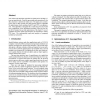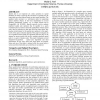GEOINFORMATICA
1998
14 years 5 months ago
1998
Due to the increasing popularity of spatial databases, researchers have focused their efforts on improving the query processing performance of the most expensive spatial database ...
VLDB
1995
ACM
14 years 9 months ago
1995
ACM
The spatial join operation is benchmarked using variants of well-known spatial data structures such as the R-tree, R-tree, R+-tree, and the PMR quadtree. The focus is on a spatia...
GIS
1997
ACM
14 years 9 months ago
1997
ACM
Spatial indexes, such as the PMR quadtree, are important in spatial databases for efficient execution of queries involving spatial constraints, especially when the queries involve...
ADBIS
1995
Springer
14 years 9 months ago
1995
Springer
One of the most important operations in spatial access needed systems are spatial joins. Using for processing such operations R-tree like structures is intensively studies now. Th...
GIS
2007
ACM
14 years 9 months ago
2007
ACM
Spatial join is an important yet costly operation in spatial databases. In order to speed up the execution of a spatial join, the input tables are often indexed based on their spa...
SIGMOD
1994
ACM
14 years 9 months ago
1994
ACM
Spatial joins are one of the most important operations for combining spatial objects of several relations. In this paper, spatial join processing is studied in detail for extended...
IGIS
1994
14 years 9 months ago
1994
The basic concept for processing spatial joins consists of two steps: First, the spatial join is performed on the minimum bounding rectangles of the objects by using a spatial acce...
SIGMOD
1996
ACM
14 years 9 months ago
1996
ACM
This paper describes PBSM (Partition Based Spatial
SIGMOD
2000
ACM
14 years 9 months ago
2000
ACM
We discovered a surprising law governing the spatial join selectivity across two sets of points. An example of such a spatial join is "find the libraries that are within 10 m...
ICPADS
2000
IEEE
14 years 9 months ago
2000
IEEE
The most costly spatial operation in spatial databases is a spatial join with combines objects from two data sets based on spatial predicates. Even if the execution time of sequen...





